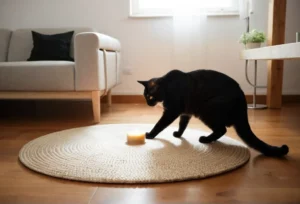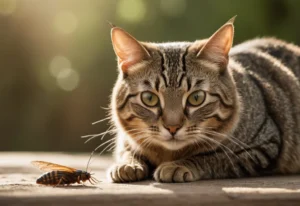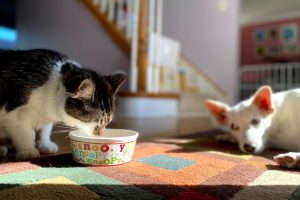Owls eating cats may sound like something out of a horror movie, but for some unfortunate felines, it’s a harsh reality. Why do owls hunt and consume cats? Let’s take a closer look at the reasons behind this shocking behavior.
Cat-eating owls: A surprising phenomenon that raises many questions and concerns. But fear not, for we have the answers you seek. Let’s delve into the world of owls and their unusual dietary habits.
The Circle of Life: Understanding Owls’ Diet
Owls, being nocturnal predators, have a diverse diet that includes small mammals, insects, and even other birds. While it may come as a shock to some, cats can also fall prey to these silent hunters. In the grand scheme of things, owls play a crucial role in maintaining the balance of their ecosystem by controlling the population of rodents and other small creatures.
It’s essential to recognize that owls are opportunistic hunters. They go for the easiest target available to them, and unfortunately, sometimes that might be a curious pet cat venturing out at night. This behavior is not out of malice but simply a natural instinct for survival. As such, it’s important for pet owners to take precautions to ensure their furry friends’ safety, especially at night.
Night Hunters: Owls’ Predatory Behavior
Under the veil of darkness, owls emerge as masters of stealth, relying on their superior vision and acute hearing to locate their prey. Cats, particularly those that are outdoor roamers, can unwittingly become a target for these skilled hunters.
Owls are known for their unique ability to rotate their heads up to 270 degrees, allowing them to pinpoint their target with precision. When hunting, owls swoop down silently from above, catching their prey off guard. Despite their reputation as wise creatures, owls are fierce and efficient predators when it comes to securing a meal.
In a list of potential prey items for owls, cats may seem like an uncommon choice. However, due to their size and behavior patterns, cats can become vulnerable targets for owls during their nocturnal hunting expeditions. To prevent such incidents, pet owners should consider keeping their cats indoors at night and ensuring their safety from these majestic yet formidable predators.
Remember, owls are an integral part of our ecosystem, and understanding their dietary habits helps us appreciate the delicate balance of nature. By taking proactive measures to protect our pets, we can coexist harmoniously with these magnificent birds of prey.
Size Matters: Why Owls Target Cats
Cats make a tempting meal for owls due to their convenient size. In comparison to larger prey like rabbits or squirrels, cats are easier for owls to catch and carry. The average size of a cat falls within the preferred hunting range for many owl species, making them a practical target.
Urbanization has also played a role in the owls’ preference for cats. With natural habitats disappearing due to human development, owls have adapted to living in urban environments. This shift has increased the likelihood of owls encountering domestic cats, leading to more frequent predation.
To help protect your furry friends, consider keeping them indoors, especially at dusk and dawn when owls are most active. By taking precautions and being aware of owl behavior, you can reduce the risk of cats falling prey to these nocturnal hunters.
Extra tip: Installing motion-activated lights or deterrents in your yard can also help deter owls from approaching your property.
Urban Encroachment: Owls and Cats in Urban Environments
Urbanization has brought about significant changes in the dynamics between owls and cats. As more owls adapt to urban settings, they increasingly come into contact with domestic cats. The abundance of human settlements attracts both prey and predators, creating opportunities for owls to target cats as a source of food.
With cats roaming freely outdoors in urban areas, they become vulnerable to owl attacks, particularly during the night. Owls are skilled hunters that can silently swoop down on unsuspecting cats in the dark, making it crucial for pet owners to take precautions to ensure their safety.
To minimize the risk of owls preying on cats, pet owners can create enclosed outdoor spaces for their cats to enjoy the outdoors safely. Additionally, using collars with bells can alert wildlife to a cat’s presence, potentially deterring owls from targeting them.
Remember to be mindful of owls in your area and take steps to protect your feline companions from potential predators. By understanding the interactions between owls and cats in urban environments, you can help ensure the safety of your pets.
Mitigation Strategies: Keeping Cats Safe from Owls
It’s heartbreaking to imagine our beloved feline friends becoming prey for owls. To protect your cats from owl attacks, you can take some proactive measures. Here are some practical tips to keep your cats safe:
- Keep cats indoors: The safest way to prevent owl attacks is to keep your cats indoors, especially during dawn and dusk when owls are most active.
- Install motion-activated lights or sprinklers: These can startle owls and deter them from coming too close to your property.
- Create barriers: Plant dense shrubs or install netting around your yard to make it more difficult for owls to swoop down and snatch your cats.
- Avoid leaving food outdoors: Food left outside can attract wildlife, including owls. Feeding your cats indoors can help minimize the risk.
- Provide hiding spots: Creating places where your cats can hide when outdoors, such as dense bushes or secure structures, can offer them a safe retreat if an owl approaches.
By implementing these strategies, you can significantly reduce the chances of owls preying on your beloved feline companions.
Rare Occurrences: Instances of Owls Eating Cats
While it may seem like a scene from a horror movie, there have been documented cases of owls preying on cats. One notable study from the Journal of Raptor Research reported instances of Great Horned Owls, in particular, targeting cats as prey in urban areas. In these cases, the owls opportunistically hunt cats roaming outside, leading to fatal encounters.
One specific case involved a Great Horned Owl capturing a cat in a backyard in Texas. The encounter was captured on a security camera, highlighting the stealth and agility of these birds of prey.
Though rare, these incidents serve as a reminder of the potential dangers owls can pose to outdoor cats. By staying informed and implementing preventive measures, pet owners can help ensure the safety of their furry companions.
Misconceptions: Debunking Myths About Owls and Cats
Despite popular belief, owls do not typically prey on cats. Owls are skilled hunters that primarily target small mammals such as mice, voles, and rabbits. While it is true that owls have been known to attack small pets like kittens or small dogs in rare cases, these instances are quite uncommon and not a regular part of their diet. Owls generally pose little threat to adult cats, as felines are agile and able to defend themselves against potential owl attacks.
It is essential to debunk the myth that owls specifically target cats for food. Owls hunt based on opportunity and availability, focusing on small rodents for their primary sustenance. Understanding the natural behavior and diet of owls can help dispel misconceptions and promote a more accurate view of these fascinating birds of prey.
Fun Fact: Strange Prey Choices of Owls
Owls are known for their varied diet, which includes a surprising range of animals beyond just small mammals. While rodents like mice and rats make up a significant portion of their diet, owls are also known to prey on insects, fish, amphibians, and even other birds. Some owl species have been documented consuming unexpected prey items such as snakes, bats, and even scorpions.
This diverse palate showcases the adaptability and resourcefulness of owls as hunters. Their ability to target a wide array of prey demonstrates their crucial role in maintaining ecological balance within their habitats. So, next time you see an owl, remember that these birds are not picky eaters and play a vital role in controlling various animal populations in the wild.
Close Encounters: Personal Stories of Owls and Cats
Have you ever heard stories of owls preying on cats? Let’s dive into some personal encounters shared by individuals who witnessed such interactions. One cat owner described how their outdoor cat went missing, only to find owl feathers nearby, suggesting a possible owl attack. Another person shared how they spotted an owl swooping down on a neighborhood cat while out for a walk in the evening. These encounters highlight the harsh reality that owls may indeed see cats as potential prey in certain situations.
Curiosity Killed the Cat: An Exploration of Owl Behavior
Owls are known for their inquisitive nature, which can sometimes lead to them targeting cats as prey. Cats, being small and agile creatures, can attract the attention of owls due to their movements and behavior. Additionally, owls have exceptional vision and hunting skills, making them efficient predators in the wild. When owls spot a cat moving in the dark, they may see it as an opportunity for a successful hunt. This combination of natural instincts and hunting prowess is what drives owls to occasionally view cats as a potential meal.
Additional Insight: Factors Affecting Prey Selection
- Size and Behavior: Owls typically target prey that is smaller and more easily manageable. Cats, especially smaller or more vulnerable ones, may fall into this category based on an owl’s perspective.
- Opportunistic Behavior: Owls are opportunistic hunters, meaning they will go after whatever prey is readily available and fits their hunting criteria. If a cat crosses paths with an owl at the wrong time, it could become the target of the owl’s hunt.
- Habitat Interaction: Urban environments can bring owls and cats into closer contact, increasing the likelihood of predatory encounters. The presence of artificial light sources in cities may also make cats more visible targets for nocturnal owls.
Protective Measures: Safeguarding Your Feline Friends
As much as we adore our furry feline companions, it’s crucial to take precautions to keep them safe from potential owl attacks. Here are some practical tips to help you protect your beloved cats:
Keep Them Indoors: One of the most effective ways to safeguard your cats is by keeping them indoors, especially during dusk and dawn when owls are most active.
Secure Outdoor Enclosures: If your cats enjoy some outdoor time, consider investing in a secure outdoor enclosure or catio to provide them with a safe space to explore without the risk of owl encounters.
Install Motion-Activated Lights: Installing motion-activated lights in your yard can help deter owls from approaching your property, reducing the likelihood of an owl-cat confrontation.
Trim Trees and Shrubs: Owls often perch on trees and shrubs before swooping down to catch their prey. By trimming back overgrown vegetation around your home, you can eliminate potential hiding spots for owls.
Supervise Outdoor Time: When allowing your cats outside, make sure to supervise them closely to intervene quickly if you spot any signs of owl activity nearby.
Remember, while we cherish the beauty of owls, it’s essential to prioritize the safety of our treasured feline friends by taking proactive measures to prevent owl-cat conflicts.
For more in-depth guidance on creating a cat-friendly outdoor space, check out this informative resource from the American Society for the Prevention of Cruelty to Animals (ASPCA): Creating a Cat Garden
Alex, a passionate animal lover, has experience in training and understanding animal behavior. As a proud pet parent to two dogs and three cats, he founded AnimalReport.net to share insights from animal experts and expand his knowledge of the animal kingdom.




